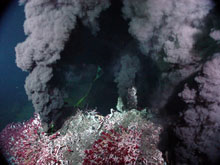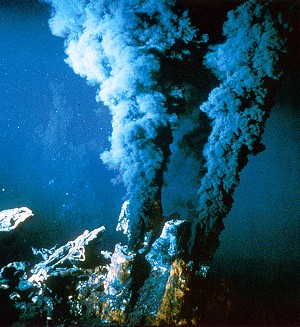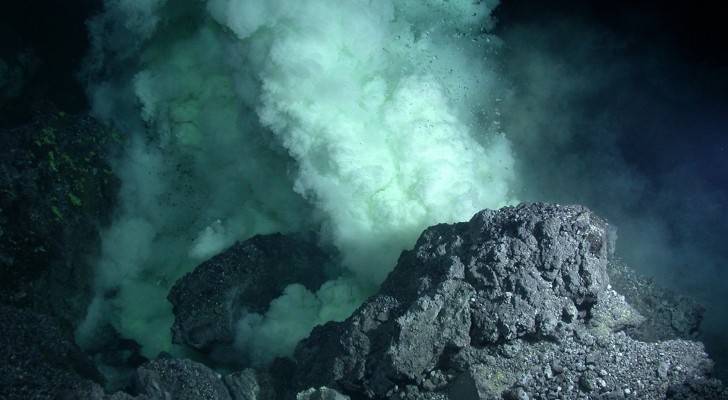Hydrothermal vent#Black smokers and white smokers
Black smokers and white smokers (English: Black and White Smoker Smoker) belong to the hydrothermal vents at the bottom of the deep sea. The mouth is formed by a tube-or cone-shaped mineral structure, stack, exiting a sediment cloud.
Properties
The water exiting the smoker especially sulphides and other salts of iron, manganese, copper and zinc, are dissolved. The hot when exiting up to 400 ° C, mineral-rich waters of the thermal spring coincides with the 2 ° C cold water of the ocean floor; during the cooling of minerals are precipitated, forming the " plume " and by sedimentation the chimney or cone. If the sediment cloud rich in iron salts (eg pyrite ), the characteristic black gray " plume " of the black smoker forms, or on the basis of sulfates ( anhydrite and gypsum) or silica sediment the bright cloud of white smoker.
The highest water temperatures were measured at black smokers, reached the two vents Two Boats and Sister Peaks on the Mid-Atlantic Ridge in 3000 m depth, which eject plume as hot water at a water pressure of 298 bar up to 464 degrees Celsius.
The chimneys of black smokers reach heights of about 20 to 25 meters on average. Hydrothermal vents of different chemical composition, such as those of the Atlantic hydrothermal field Lost City, however, significantly higher chimneys can develop and reach heights up to 60 meters (as of 2001).
Smoking as biotopes
Deep-sea hydrothermal sources and their environment form their own habitat with many, mostly living only in these types of environments. Base of the food chain in this biotope form active chemosynthetic bacteria and archaea, the use in the hot environment, the oxidation of hydrogen sulfide as an energy source in order to, among other things carbon dioxide as a carbon source to build organic compounds from inorganic substances. On a 2,500 -meter-deep black smokers at the East Pacific green sulfur bacterium back one was discovered, which operates a anoxygenic photosynthesis with hydrogen sulfide or sulfur as a reducing agent. At this depth, no sunlight reaches the bacteria. But its extremely light-sensitive asset chlorosomes the long-wavelength red and the heat radiation (near infrared) to catch the escaping hot hydrothermal solution of the hydrothermal source and to make as an energy source for photosynthesis usable.
Further, the habitat is inhabited among others by spider crabs without eyes, beard worms, clams and mussels and starfish. The living here beard worms have no digestive system, but also get their nutrients from bacteria with which they live in symbiosis. These bacteria live in well-perfused organs of beard worms, called Trophosomen, making the beard worms have direct access to the formed by the bacterial organic matter.
Fields of hydrothermal deep-sea vent are only about 20 years active. Then the precipitated minerals clog the tubes and columns and the sources dry up. Thus dies the fauna in the now hostile to life has become for her surroundings. As life comes to new fields of hydrothermal vents, is not explored so far.
There are currently two different theories, both of which are not yet sufficiently proved:
Not only for environmental reasons, but also because of the deposited near her ore, black smokers are of interest to the people. It is feared that the planned mining of gold and rare non-ferrous metals affect the ecosystems, or may even be destroyed. The Autonomous Government of the Azores decided in 2002, two particularly important areas - the hydrothermal fields Lucky Strike and Menez Gwen - to provide as marine protected areas under protection.
Hypotheses about the evolution of life
The extreme environmental conditions, such as prevail in the hydrothermal fields of the deep sea near the black smokers leave, think about the conditions in the early history of the earth, in which evolutionary biologists see the origin of life on Earth. Volcanism with high temperatures and high pressure, lack of light and a high concentration of minerals, some researchers (eg Günter Wächtershäuser ) moved to allocate around black smokers of particular importance in the development of life. In particular, the active chemosynthetic bacteria and archaea (formerly referred to incorrectly as archaebacteria ) hydrothermal vents, whose genome has been extensively studied and could be completely deciphered in many ways contributed to this. They are considered because of their anaerobic metabolism and energy production without the possibility of using sunlight as well as their habitat, which was very common on the early Earth, by some researchers to be representative of the earliest forms of life. Some biologists expect to find similar life on moons of the gas giant planets such as Jupiter 's moon Europa, since there under the ice shell a water ocean with possible hydrothermal sources is suspected.
Other living around hydrothermal vents organisms such as sitting in long tubes beard worms and Pompejiwürmer with reduced digestive organs or scallops of the genus Calyptogena magnifica that live in symbiosis with chemoautotrophic sulfur bacteria, are highly specialized and adapted and rather than products of a long lasting evolution than as to denote the origin. Overall, the black smokers have already triggered with its extraordinary ecosystem and new species since its discovery many intensive discussions and further research among scientists in all fields of oceanography and geology, but also genetics, paleontology, microbiology, biochemistry and medicine.










